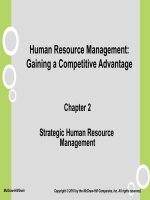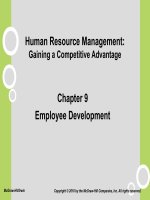Human resource management gaining a competitive advantage 2014 chapter 15
Bạn đang xem bản rút gọn của tài liệu. Xem và tải ngay bản đầy đủ của tài liệu tại đây (236.99 KB, 15 trang )
Introduction
• Organizations now function in a global
economy.
• International expansion can provide a
competitive advantage:
– Entering different countries may provide
large numbers of potential customers.
– Building production facilities in countries with
low-cost labor may prove cost-efficient.
• Maquiladora plants
– The rapid increase in telecommunications
and information technology enables work to
be done more rapidly, efficiently, and
effectively around the globe.
15-1
Current Global Changes
• European Economic
Community
• North American Free Trade
Agreement
• The Growth of Asia
– Japan, China, Singapore,
Hong Kong, and Malaysia are
significant economic forces.
• General Agreement on
Tariffs and Trade (GATT)
15-2
Factors Affecting HRM in
International Markets
Education Human Capital
Culture
Human Resource
Management
Economic
System
Political-Legal
System
15-3
Hofstede’s Cultural Dimensions
• Individualism/collectivism - the degree to
which people act as individuals rather than as
members of a group.
• Power distance - how a culture deals with
hierarchical power relationships.
• Uncertainty avoidance - how cultures deal
with the fact that the future is not perfectly
predictable.
• Masculinity-femininity describes the division
of roles between the sexes within a society.
• Long-term/short-term orientation - the
tendency of a culture to focus on long-term
benefit or short-term outcomes.
15-4
Implications of Culture for HRM
• Cultures differ on such things as
leadership, decision-making, and
motivation.
• Cultures influence the
appropriateness of HRM
practices.
• Cultures may influence
compensation systems.
• Cultural differences can affect the
communication and coordination
processes in organizations.
15-5
Education/Human Capital
• Countries differ in their levels of human
capital.
• A country's human capital is determined
by a number of variables, primarily,
educational opportunity.
• Countries with low human capital attract
facilities that require low skills and lowwage levels.
• Countries with high human capital are
attractive sites for direct foreign
investment that creates high-skill jobs.
15-6
Political/Legal System
• Dictates the requirements of certain HRM
practices, such as training, compensation,
hiring, firing, and layoffs.
• The legal system is an outgrowth of the culture,
reflecting societal norms.
– United States has led the world in eliminating
discrimination in the workplace and controlling
the process of labor management negotiations.
– Germany has provided employees with a legal
right to "codetermination" in the workplace.
– The EEC provides for the fundamental social
rights of workers: freedom of movement and
freedom to choose one's occupation and be fairly
compensated.
15-7
Economic System
• Under socialist economies, there
is little economic incentive to
develop human capital, but
ample opportunity exists
because education is free.
• In capitalist systems, the
opposite situation exists, with
higher tuition at state universities
but economic incentives exist
through individual salaries
15-8
Types of International Employees
• A parent country is the country in which
the company's corporate headquarters is
located.
• A host country is the country in which the
parent country organization seeks to locate
(or has already located) a facility.
• A third country is a country other than the
host country or parent country.
• An expatriate is an employee sent by a
company in one country to manage
operations in a different country.
15-9
Types of International Employees
• Parent-country nationals (PCNs) are
employees who were born and live in a
parent country.
• Host-country nationals (HCNs) are those
employees who were born and raised in the
host country, as opposed to the parent
country.
• Third-country nationals (TCNs) are
employees born in a country other than the
parent country or host country but who work
in the host country.
15-10
Levels of Global Participation
Domestic
Parent
Country
Host
Country
International
Corporate
headquarters
Corporate
headquarters
Foreign
subsidiary
Foreign
subsidiary
Multinational
Corporate
headquarters
Foreign
subsidiary
Global
Corporate
headquarters
Foreign
subsidiary
Foreign
subsidiary
Increasing Participation in Global Markets
15-11
Global Organizations
• Global organizations compete on state-ofthe-art, top-quality products and services
with the lowest possible costs.
– Transnational scope refers to the fact that HR
decisions must be made from a global rather
than a national or regional perspective.
– Transnational representation reflects the
multinational composition of a company's
managers.
– Transnational process refers to the extent to
which the company's planning and decisionmaking processes include representatives and
ideas from a variety of cultures.
15-12
Selection of Expatriate Managers
• Successful expatriates have the following
skills or abilities:
– Technical competence
– Ability to adjust to, and be sensitive to, a new
culture. Three dimensions include:
• the self dimension
• the relationship dimension
• the perception dimension
• Use of women in expatriate assignments
has proven beneficial for companies; recent
evidence disproves the notion that women
are not successful managers in foreign
countries.
15-13
Compensation of Expatriates
• Total pay packages have four
components:
– Base Salary—Annual salary,
unadjusted.
– Tax Equalization allowances—
Payments for higher tax rates of
other countries.
– Benefits—Continuation of, or
substitute for, home benefits.
– Allowances—Cost-of-living,
housing, education, and
relocation payments.
15-14
Reacculturation of Expatriates
• Reentry to the home organization may
result in culture shock.
– According to some sources, 60 to 70 percent
of expatriates do not know what their
position will be upon their return.
• Transition process necessitates
communication of corporate changes while
the expatriate is overseas and validation of
the importance of the expatriate's
international work.
15-15









